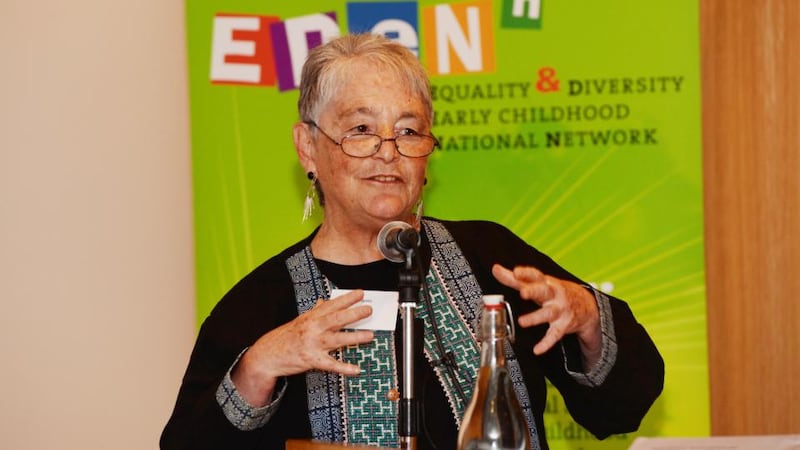Everybody knows one little girl in the pre-school class is a Traveller but nobody talks about it. However, when one of her classmates is having a birthday party, she is the only child not invited.
Members of the pre-school staff are horrified – particularly, as it happens, because they are in the middle of a training programme run by the Equality and Diversity Early Childhood National Network (EDeNn). They realise they are not supporting this Traveller child to be equal among her peers.
So they invite the girl’s father, who collects and sells periwinkles, into the pre-school to talk about his work. All the children are fascinated to hear about, handle and even taste the edible sea snail. Photographs are taken for a booklet about periwinkles and his proud daughter is “queen” for the day.


This was the scenario in one pre-school in the west of Ireland, as recounted by Colette Murray, EDeNn co-ordinator and lecturer in Blanchardstown Institute of Technology. But the initial act of exclusion is undoubtedly repeated in many others, be it on grounds of race, religion, culture or family type.
Blame it on the adults, you might say. Surely any group of small children play along happily, blissfully oblivious to such differences?
Not so, according to Murray. “It is one of the myths that children don’t notice difference. Children categorise from a very early age.”
But noticing difference is not the problem. It’s the attitudes that filter down from society to those differences which sow the seeds of prejudice in very young minds.
Early childhood care workers who are aware of the impact of those attitudes and are trained to build on children's natural curiosity about differences are able to explain how people are both different and the same, says Louise Derman-Sparks, a leading US advocate of anti-bias education, who was in Dublin recently to address a conference entitled Making a Difference for All Children.
Sources of prejudices
Sitting in the offices of Start Strong, which jointly organised the conference with EDeNn, she explains: "The bias and the prejudices that affect young children come from family, from media, they even come from toys." Some come as misinformation in the form of stereotypes and some are a result of invisibility – "because what you don't see is not important".
The flip side of that is if you are visible and your image is reflected in pictures, posters, books and TV programmes, it not only helps you develop a positive self-concept but it also makes you think that people who don’t look like that may have something wrong with them. And if you are a child who doesn’t see themselves in materials around you, “then there is the feeling that you are not worth as much as the people who are visible”.
Pre-school is the first bridge out of the family home into wider society, she points out, so children’s experience of inclusion or exclusion at that stage is likely to have a significant impact on their formative years.
The trouble is many people running early childhood centres in Ireland think they are inclusive, when in fact they’re not. The phrase Murray hears repeated time and time again is “but I treat all the children the same . . .”.
However, she explains, if you are working with children and want to be inclusive, you need to be treating children differently, actually, to enable them to be treated equally.
It may sound counter-intuitive, but Derman-Sparks stresses that it is important to acknowledge difference from the outset rather than pretend it doesn’t exist.
"It is treating people in the context of their family life – who they are," she says.
Course in diversity
Murray co-ordinated a national training programme, the Pre-school Education Initiative for Children from Minority Groups, which was funded by the Department of Education and Skills and ran in 2011 and 2012.
Based on the anti-bias approach devised by Derman-Sparks, the 70-hour course encouraged participants to examine their own attitudes to diversity as well as looking at what they could do as childcare professionals.
A very good example of personal reflection is to look at what way you think about the Traveller community, suggests Murray.
“Across Irish society, people have an opinion about Travellers – how are you informed [about Travellers] and how do you learn to think differently about them?”
Diversity is about making sure the pre-school environment and materials reflect all of the children, says Derman-Sparks. “But that is not enough, if you don’t deal with the attitudes.”
Training helps childcare professionals talk to families about the best way to support their child, says Murray. Whereas before they would have been nervous about approaching the parents, fearing that they would be regarded as nosey or interfering.
"My experience is that when parents are asked in an appropriate way, they are delighted and willing to contribute," she reports. "They want their children to fit in as well."
Improvement in quality
Once they start embracing families, childcare practitioners say not only does it enhance diversity but it improves quality in their practice.
Diversity is not just about focusing on the non-national communities who have come into Ireland in recent years and holding “cultural days” to celebrate those children.
“We call that the ‘tourist approach’,” explains Derman-Sparks. “The majority look at the minority cultures and then go back to doing what they are doing, reflecting only the majority perspective.”
True diversity is reflecting a broad spectrum of differences, be they cultural, religious, skin colour, family type or physical or mental abilities, in everything that is done at pre-school. And it is as important for the children from the majority community as it is for those from minorities because, as Murray points out, “we live in a diverse world”.
For more information see edenn-org or startstrong.ie
swayman@irishtimes.com











